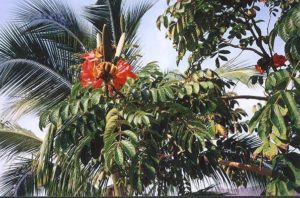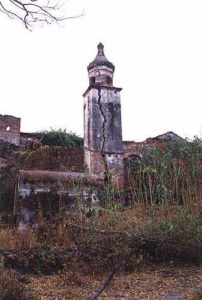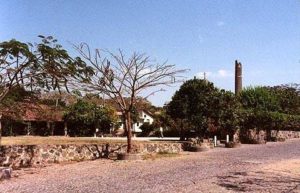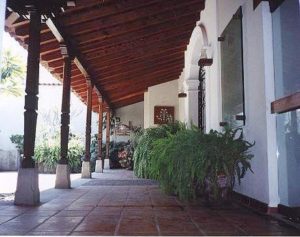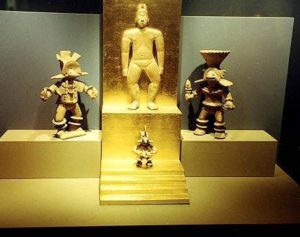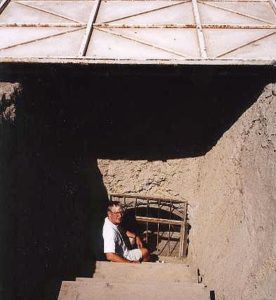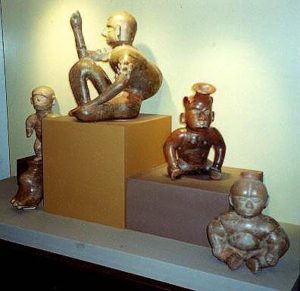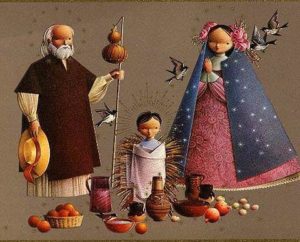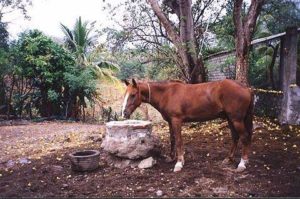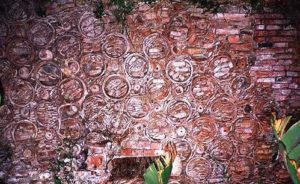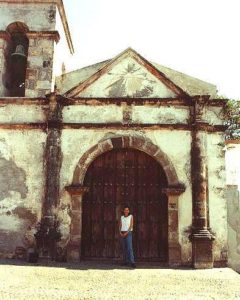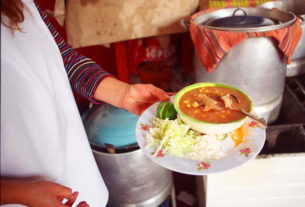La Hacienda de Nogueras is an elegantly restored hacienda hidden in the countryside of Colima. Six miles north of Colima City, it links the region’s rich pre-Hispanic past with colonial and modern history.
To get there, you head towards the small town of Comala. You may drive or take a taxi from the city for about fifty pesos. When you reach the river before the Comala, turn to the right and pass the botanero. The road, Calle Degollado, winds by country estates for several kilometers until it reaches the village-like hacienda and its surroundings.
My husband, photographer Bill Arbon, and I enjoyed a private invitation to spend a night at the hacienda. We also attended a gala sponsored by the tourism office. On the hacienda’s patio, mariachis from Colima sang and danced on the steps, overflowing with flowers and shrubbery.
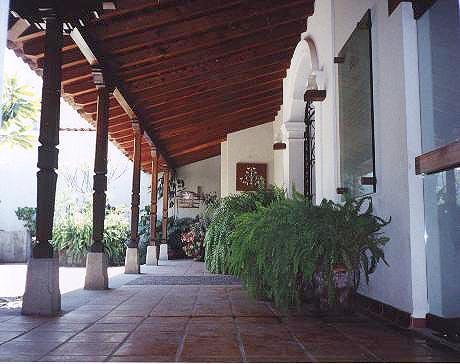
The region’s early inhabitants called the land, Ajuchitlán or the Valley of the Flowers. They founded their settlements near water flowing down the slopes of the Vulcan de Fuego. In the valley below the fiery volcano, a uniquely western civilization prospered for thousands of years. After the Spaniard’s 1531 campaign, Hernan Cortez granted this land to a now forgotten general. Franciscan monks arrived to evangelize the native survivors. They founded the first chapel of Ajuchitlán.
Over the next few centuries, ownership of the land changed several times. During the 17th century, Captain Juán Vicente of Nogueras built the sugar cane hacienda that bears his name. Sugar cane thrived in the fertile volcanic soil. Approaching the hacienda, you can still see the sugar cane chimney behind the high wall.
By 1873, the Hacienda of Nogueras was mortgaged for $19,000 pesos and the products from the sugar cane mill. The Rangel family purchased the bankrupt hacienda. They ran the sugar cane mill until the Mexican Revolution of 1917-1927. When their property was reduced to a few hectares, they introduced the intensive cultivation of a new crop, lemons. After Alejandro inherited the hacienda, he directed his talents as an artist to maintaining the economy of Nogueras. He dedicated himself to helping the hacienda’s former workers and their families stay in the village.
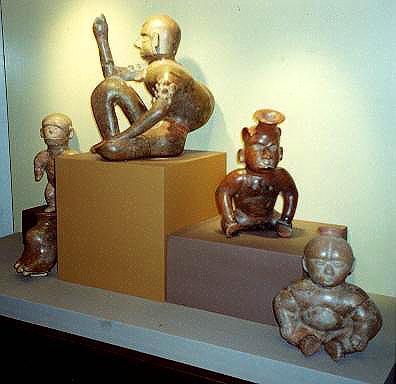
With help from his wife, Margarita Septién Rul, Alejandro remodeled the hacienda. There he designed a museum to feature his antiquities, artwork and furniture. As you enter the museum, witness Alejandro’s artistic signature everywhere; in the architecture, display cases, wrought ironwork; the patio and its flowers. Even the guest cottage contains Alejandro’s furniture and designs.
Another example of his touch is found in his ‘horno’ or oven room. Here, special lighting spotlights the creativity and beauty of ancient ceramics found around the hacienda. The pieces are funerary offerings from Pre-Hispanic ‘shaft tombs’. A shaft measures up to 8 meters deep, with one or more rooms created at 90-degree angles. Entire families and sometimes servants, dogs and other animals, lie buried alongside pottery, dishes, utensils and tools.
The ceramics are fashioned into an inspiring repertoire of wild and domestic animals, people and even vegetables. Some display a sophisticated geometry. Others demonstrate the activities of daily life: working, farming, cooking, creating music, playing games or making love. Warriors, priests, artists, women, children are all represented. One display case depicts congenital and developmental abnormalities. The ancient artisans portrayed with skill and tenderness, the conditions now known as spina bifida, cleft palate and Down’s syndrome.
Ninety-five percent of the figures are hollow. Each has a hole to allow the hot air in the oven to flow in and out to improve the drying process. ‘Colima Dogs,’ distant relatives of the Mexican Hairless and the Chihuahua, feature prominently in the ceramics as pets, or perhaps food.
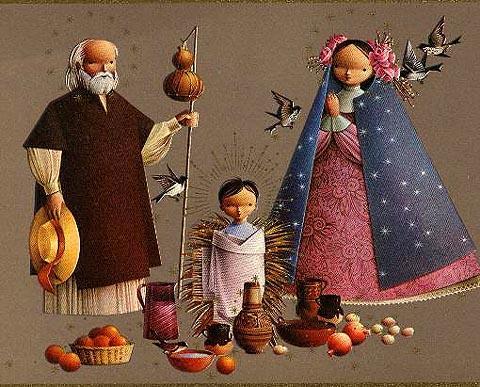
Another room displays a portion of the Christmas card collection that Alejandro created for the United Nations children’s organization, UNICEF. In exquisite detail, he depicted Christmas costumes and customs around the world and throughout the ages; Spain under Phillip II, Italy during the Renaissance, French Gothic, Mexican Colonial, Victorian England, Germany, Pilgrims in America, Norway and Russia.
Another room creates a replica of a traditional hacienda. A ‘zarzo’ hangs from the ceiling to keep the animals away from the food. A ‘metate’ stands in a corner for grinding corn, surrounded by water filters, irons, blown glass bottles, storage containers, tools and coffee grinders.
A fourth room features many pieces of quality furniture that Alejandro designed and created at the hacienda. Furniture, like the pieces in this room, found its way to many Mexican embassies and even the President’s house at ‘Los Pinos’. This room also contains some of Rangel’s earliest paintings. Many of his paintings portray the fusion of the Mexican and Spanish culture. For example the virgins have dark skins and the angels wear feathers about their heads. His unique style has become known as ‘Rangelino’.
In the 1960’s Alejandro started a school for artisans. With the help of his brother and federal funding, they founded ‘Artisans of Comala’, near Nogueras. In addition to carpentry, the school instructed three hundred local artisans in wood, iron, leather, gold leaf, paper (flowers), blown glass and paint and furniture finishes.
Adjoining the museum is the ancient capilla or chapel, originally founded by Franciscans. Services are still held here. Emilia Rangel Brun, curator and niece of the artist, has plans to extend the museum.
“I want to display some of Alejandro’s earlier work,” she explains. “My uncle painted in other, more controversial styles. I want people to see them too.”
Emilia and her guides lead insightful tours. You will be given an introduction to the museum written in English in order to understand the exhibition. In addition, outside the museum, you can wander the cobblestone streets surrounding the peaceful hacienda. During museum hours, the gift shop, ‘The Enchanted Iguanas’ and a restaurant are open for business.
When Bill and I stayed the night, roosters and car engines together broke the morning calm. Two children rode by on a donkey, going to school and passing a horse drinking from an old stone cistern. While wandering behind the hacienda, we discovered ancient crumbling walls and a lush ecological park. Impressive stands of bamboo towered on the bank beside a dry riverbed. Birds, butterflies or flowers surrounded our steps.
Upon his death on February 7th, 2000, Alejandro bequeathed the Hacienda of Nogueras to the University of Colima. By this act, the artist honored a pact with the ancient inhabitants of Nogueras. Their treasures can stay perpetually, on the land where they were buried. Today the University runs the hacienda as a center for archeological, historical and anthropological studies.
If authentic things resist the passage of time, then the hacienda of Alejandro Rangel Hidalgo will be treasured by generations to come.
THE MUSEUM OF ALEJANDRO RANGEL HIDALGO
Centro Cultural Nogueras, Comala ten kilometers north of Colima City
Hours: Tuesday through Friday, from 10 a.m. till 2 p.m. and 5:30 till 7:30 p.m. Saturday and Sunday, 10 a.m. to 6 p.m. Closed Mondays.
There is a charge of 20 pesos per person to enter the museum.
SOURCES OF INFORMATION
Books
Alejandro Rangel Hidalgo, Artista Universal, First edition 2001 (Spanish) Universidad de Colima, Avenida Universidad 333 Colima, Colima, Mexico.
Burton, Tony. Western Mexico, A Traveller’s Treasury , 1994
Dearing, Susan. Manzanillo and the State of Colima “Facts, Tips and Day Trips”, Endorsed by the department of tourism of Colima, and the city of Manzanillo. Available at Underwater Scuba, A.P. 295, Santiago, Colima, Mexico 28861 U.S. Distributor, Diane Johnson, 11811 N. 30th Place, Phoenix, AZ 85028 Or order by fax at 52-333-33678 or phone at 52-333-30642 or Internet from: [email protected]
Whipperman Bruce, Pacific Mexico Handbook , 2001
Pamphlet
De La Madrid Alfonso C. Dates about the Hacienda of Nogueras, May 6, 1972
THE MUSEUM OF ALEJANDRO RANGEL HIDALGO

